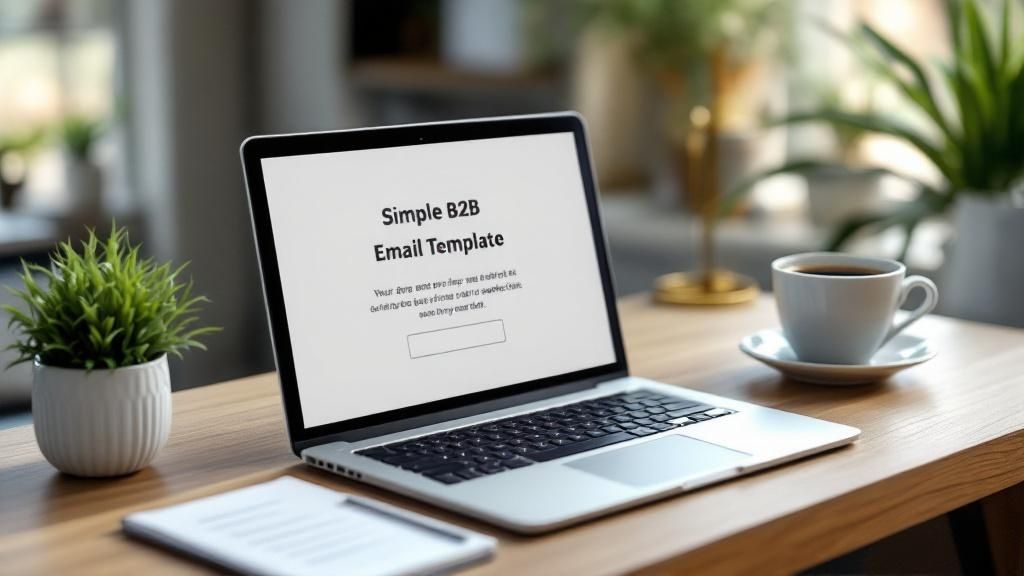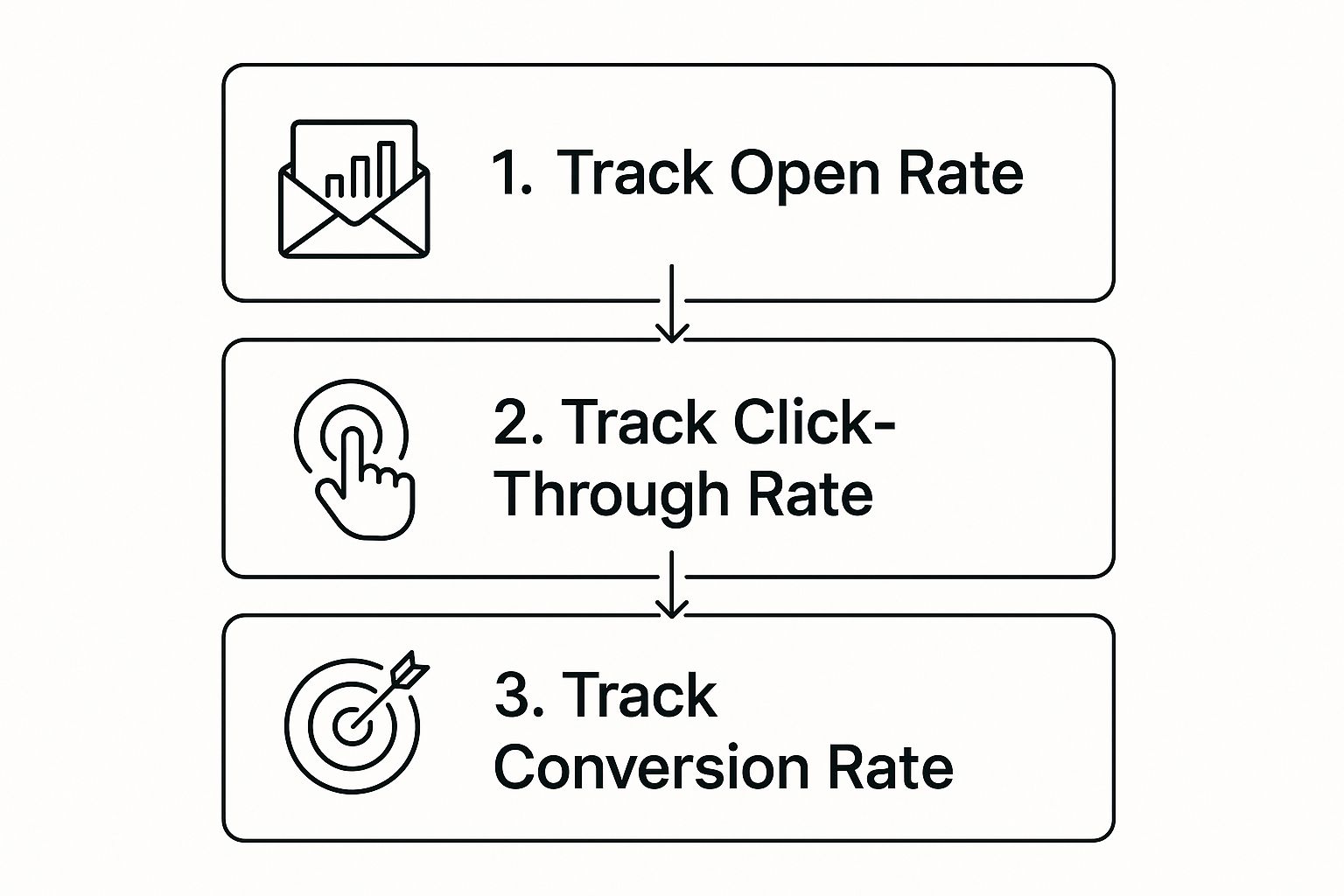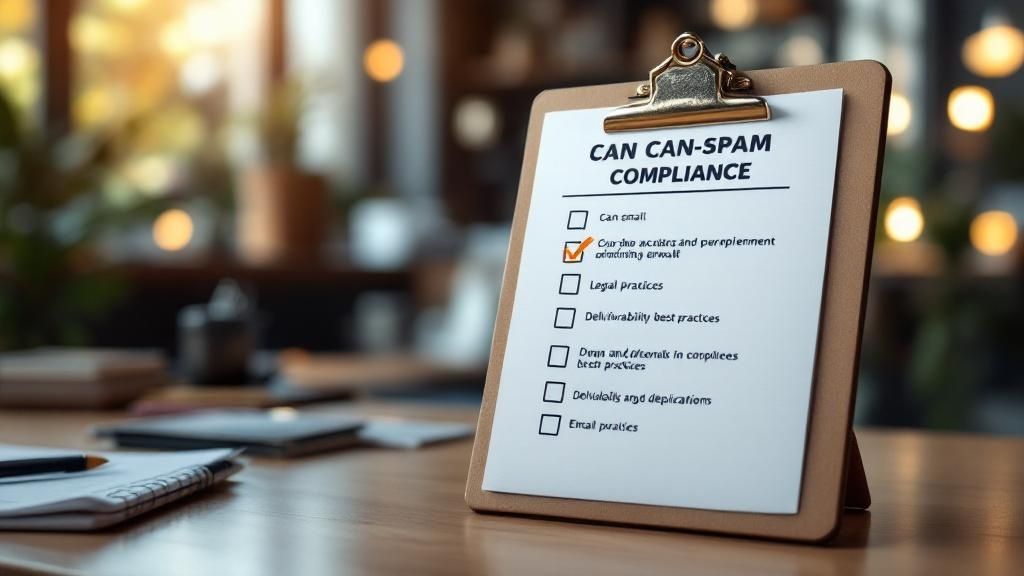A successful B2B email marketing strategy isn't just about sending messages. It’s built on a solid foundation of clear goals, a deep understanding of who you’re talking to, and staying on the right side of the law.
Before you even think about hitting 'send', you need a scalable, legal framework. This is what protects your brand's reputation and ensures your emails actually make it to the inbox.
Building Your Foundation for B2B Email Success

It's easy to get excited and jump straight into writing copy or designing a slick new template. I've seen it happen countless times. But the campaigns that truly deliver results start with a strong, strategic groundwork. Without it, your efforts will feel scattered and you'll have no real way to measure what's working.
This foundational stage is about building a system that ties your email activities directly to business outcomes. It’s about creating a framework that’s not only effective but also defensible, making sure your messages land with the right people and actually resonate.
Define Your B2B Email Goals
First things first, you need hyper-specific goals. "Increase engagement" sounds nice, but it's far too vague. You need to define what success looks like in concrete, measurable terms that actually connect to your company's revenue targets.
So, what are you really trying to achieve?
- Lead Generation: Is the main objective to fill the top of your funnel with new, qualified prospects?
- MQL Nurturing: Are you trying to guide Marketing Qualified Leads (MQLs) toward a sales conversation?
- Customer Retention: Do you need to boost loyalty and reduce churn with educational content and updates?
- Event Promotion: Is the goal to drive registrations for your next webinar or conference?
Each of these goals demands a completely different playbook. A lead gen campaign might dangle a high-value downloadable asset, while a customer retention campaign will lean on product tips and success stories. The content, cadence, and automations all shift based on the objective.
A goal without a measurement is just a wish. For every objective, define the Key Performance Indicator (KPI) that will track its success, such as demo requests booked, MQL-to-SQL conversion rate, or customer lifetime value.
The channel's importance can't be overstated. Projections show that the global number of email users will hit nearly 5 billion by 2025, with daily email volume soaring past 376 billion. This growth is fueling an email marketing economy expected to reach $13.69 billion—a massive opportunity if you get your B2B email strategy right. You can explore more about these trends and what they mean for marketers.
Craft Your Ideal Customer Profile and Personas
Once you have your "why," it's time to lock down your "who." In the B2B world, you aren’t just talking to a single person; you’re targeting specific individuals inside a particular type of company. This is where your Ideal Customer Profile (ICP) and buyer personas become your most valuable assets.
An Ideal Customer Profile (ICP) is a detailed description of the perfect company for your product. It’s built on firmographics like:
- Industry or vertical
- Company size (both revenue and employee count)
- Geographic location
- The tech stack they're already using
With your ideal company defined, you then zoom in and create buyer personas for the key people inside those companies. Remember, a B2B purchase rarely involves just one person. You have the end-user, the budget holder, the technical decision-maker, and sometimes a few others.
Each persona has unique pain points, motivations, and questions. Tailoring your messaging to speak directly to them is what separates an email that gets deleted from one that gets a reply. This detailed work informs every subject line you write and every CTA you create.
Establish Data Hygiene and Compliance
Finally, let's talk about the unglamorous but critical part: your list. A clean, compliant email list is the absolute bedrock of deliverability and brand reputation. Getting this right from the start will save you from massive headaches down the road.
Data hygiene is the ongoing process of cleaning your email list. This means regularly removing invalid email addresses, getting rid of duplicates, and purging subscribers who haven't engaged in months. A clean list dramatically improves your sender score and ensures your messages are reaching people who actually want to hear from you.
Equally important is compliance. You have to play by the rules, which means adhering to regulations like GDPR in Europe and the CAN-SPAM Act in the U.S. These laws dictate how you can contact people and what rights they have. Building your foundation means making consent and transparency central to your process from day one. This isn't just about avoiding fines; it's about building genuine trust with your audience.
Growing and Segmenting a High-Value B2B Email List

Let's get one thing straight about B2B marketing: a massive email list cluttered with unqualified contacts is a liability, not an asset. The real magic of an email marketing strategy for b2b comes from a curated list of high-value, engaged contacts who actually fit your Ideal Customer Profile (ICP). Quality always, always trumps quantity.
Building this kind of powerhouse list takes a two-pronged approach. You need a game plan for both organic, inbound growth and for smart, targeted outreach. When you combine these methods, you create a sustainable pipeline of prospects who genuinely want to hear from you. This focus on quality from the very beginning is what separates campaigns that resonate from those that just add to the noise.
At the end of the day, you’re not just growing a list; you're building an audience you can have real conversations with.
Attracting the Right Contacts Organically
Organic growth is all about creating a magnetic pull. You attract prospects by offering them something so useful, so valuable, that they’re more than willing to trade their contact information for it. This is where high-quality lead magnets become your best friend.
A simple "subscribe to our newsletter" pop-up just doesn't cut it anymore. B2B decision-makers are incredibly busy and fiercely protective of their inboxes. You have to earn your way in by offering genuine expertise that solves a real problem they're facing.
Some of the most effective B2B lead magnets I've seen include:
- In-depth Whitepapers: Go deep on a specific industry challenge and back up your solutions with hard data.
- Exclusive Webinar Replays: Give people on-demand access to expert discussions packed with actionable takeaways.
- Detailed Case Studies: Show, don't just tell. Showcase how a company just like theirs solved a nagging problem, complete with real results.
Once you’ve got these valuable assets, strategically place your lead capture forms on the most relevant pages of your site, like high-traffic blog posts and service pages. Keep the forms clean and simple to boost conversions—just ask for the essentials at first. For some clever ways to expand your subscriber base, you might want to see how you can grow your B2B mailing list effectively.
Pinpointing Prospects with Compliant Outreach
While organic growth builds a strong, steady foundation, targeted outreach is the accelerator. Now, this isn't about buying a shady list and hitting "send" on a mass email blast. We're talking about using sophisticated tools to find contacts who are a perfect match for your ICP and then engaging them with something truly relevant.
Platforms like Salesloop.io are purpose-built for this exact scenario. You can zero in on specific companies based on their industry, size, or even the tech they use. From there, you can pinpoint the right decision-makers by their job title, whether you're trying to reach a Head of Engineering or a VP of Marketing.
This method ensures you’re only adding highly relevant prospects to your funnel, which is a key part of any solid https://salesloop.io/blog/b-2-b-sales-lead-generation/. It’s a targeted approach that respects the recipient's time and skyrockets your chances of getting a positive response.
The Power of Smart Segmentation
Building your list is just the first step. If you're sending the same generic message to every single person, you’re completely wasting the potential of all those contacts you worked so hard to get. This is where segmentation comes in, transforming your email marketing from a broadcast into a one-on-one conversation.
Sending a generic email to your entire list is like shouting into a crowded room and hoping the right person hears you. Segmentation is like walking up to that person and starting a one-on-one conversation.
You can slice and dice your list in countless ways, but the most effective strategies usually layer multiple data points for a super-targeted approach.
Common B2B Segmentation Methods
| Segmentation Type | What It Is | Example Use Case |
|---|---|---|
| Firmographic | Based on company-level data like industry, company size, or annual revenue. | Sending a manufacturing-specific case study only to contacts in the manufacturing sector. |
| Behavioral | Based on actions contacts have taken, such as pages visited or content downloaded. | Triggering a follow-up email with pricing information to someone who just visited your pricing page. |
| Lifecycle Stage | Based on where the contact is in their journey with you (e.g., Lead, MQL, Customer). | Sending a nurturing sequence to new leads and a product update to existing customers. |
By segmenting your list, you make sure every email feels like it was written specifically for the person reading it. A CFO doesn’t care about the same technical nitty-gritty as an IT Manager, and a brand-new lead needs entirely different information than a loyal, long-time customer. In today's B2B world, this level of personalization isn't a "nice-to-have"—it's an absolute must for cutting through the inbox clutter and actually driving results.
Writing B2B Emails That Get Opened and Actioned
So you've built the perfect, hyper-targeted list. Your data is squeaky clean. None of that matters if your emails just sit there, unopened. Or worse, get instantly deleted.
In the chaos of a B2B inbox, you’ve got maybe three seconds to grab someone's attention. This isn't about spammy tricks or clickbait. It's about respecting your prospect's time and showing them you have something valuable to say, right from the get-go.
Every word, from the subject line to the final call-to-action, has a job to do. Let’s make sure it does it right.
Crafting Unforgettable Subject Lines
Your subject line is the gatekeeper. It's the first impression, and it’s what decides if your email gets a click or gets archived without a second thought. The goal here is to spark curiosity without sounding unprofessional or desperate.
A killer B2B subject line hints at a solution to a problem you know they have or teases a piece of genuinely useful information. Forget the all-caps and the trail of exclamation points. Vague phrases like "Checking in" are just as bad. Be clear and focus on the benefit.
For instance, a subject line like, “A better way to manage Q3 engineering tasks,” hits a lot harder than "New software update." It speaks directly to a specific team's daily grind. If you want to really nail this first step, our guide on cold email best practices has some great, field-tested insights.
Structuring Your Email for Scannability
Okay, they opened it. Great. Now you face the next challenge: getting them to actually read it.
Here’s a secret: B2B professionals don't read, they scan. They're hunting for keywords and key ideas to decide if your message is worth their time. A giant wall of text is an immediate deal-breaker.
To get around this, you have to design your email for easy scanning:
- Keep paragraphs short. Seriously, stick to one to three sentences. The white space makes the content look way less intimidating.
- Use bullet points or lists. When you need to break down features, benefits, or steps, bullet points are your best friend. They make complex info a breeze to digest.
- Use clear headings. Guide the reader through the email's key points, just like you would in a blog post.
This isn’t just about aesthetics; it’s about respect. This structure lets your prospect get the gist in seconds, which dramatically increases the odds they’ll actually engage with your call-to-action.
Key Takeaway: Your email copy needs to be understood at a glance. Prioritize clarity and scannability to show you value your reader’s time.
Looking for solid examples? Checking out some sample event invitation email templates can give you a feel for how to structure messages that drive action.
Using Proven Messaging Frameworks
Don't just stare at a blank page and hope for inspiration. Lean on proven copywriting frameworks to give your message a logical, persuasive flow. These are built on psychological principles that guide a reader from their problem straight to your solution.
For B2B, two frameworks are absolute gold:
- Problem-Agitate-Solve (PAS): Kick things off by hitting on a pain point your prospect knows all too well (Problem). Dig into the consequences and frustrations of that problem (Agitate). Then, sweep in and introduce your product as the clear Solution.
- Feature-Advantage-Benefit (FAB): Start with a specific product feature (Feature). Explain what that feature does (Advantage). And then, crucially, connect it to what that means for them and their business (Benefit). The benefit is what sells, every time.
Using a framework like PAS or FAB connects your pitch directly to their real-world challenges. It’s not just about what your product does; it’s about what it does for them.
And the data backs this up. A staggering 77% of B2B buyers prefer to be contacted by email, and 81% of B2B marketers use email newsletters as a core part of their strategy. Clearly, when you get it right, email works.
Using Smart Automation for Personalized Outreach
This is where your B2B email strategy really starts to pick up steam. Automation is the engine that lets you scale personalized outreach without being chained to your keyboard, crafting every single message by hand.
But let's be clear: effective automation isn't about a generic "set it and forget it" welcome email. It's about building intelligent, responsive workflows that deliver the right message at exactly the right moment. The goal is to move beyond basic sequences and create a system that reacts to how your prospects behave, using their actions as triggers for genuinely helpful communication.
When you get this right, automation doesn't feel robotic. It feels like you're actually paying attention to each prospect's journey. Every interaction becomes timely, valuable, and a clear step forward in building a real relationship.
Building Advanced Automation Workflows
To make your email marketing work harder, you have to think in scenarios. A brand-new subscriber who just downloaded a whitepaper has a totally different mindset than a long-time contact who's gone quiet. Your automation needs to recognize and adapt to this.
I've found these advanced sequences to be incredibly effective:
- Content-Triggered Nurturing: Let's say a prospect downloads a case study on your software's ROI for manufacturing firms. That's a huge signal. Trigger a sequence that follows up with more manufacturing-specific content, like a relevant blog post or an invitation to a targeted webinar.
- Re-engagement Campaigns: You'll always have subscribers who haven't opened or clicked an email in 90 days. Instead of letting them go cold, automatically send a friendly "break-up" style email. Ask if they still want to hear from you, or maybe offer them your single most valuable resource to see if you can spark their interest again.
- Detailed Onboarding Flows: Once a deal is closed, the work isn't over. Trigger an onboarding sequence that does more than just say "thanks." It should include setup guides, links to key support articles, and an introduction to their dedicated account manager.
This graphic gives you a simple way to visualize how to track the success of these automated campaigns.

As you can see, performance tracking is a connected process. It starts with opens, leads to clicks, and hopefully ends with conversions. Each metric builds on the last, giving you the full picture of how your campaigns are really doing.
To help you map out your own automation strategy, I've put together a table of essential workflows. Think of this as your starting point for building a more responsive and effective email system.
Essential B2B Email Automation Workflows
| Workflow Type | Primary Goal | Example Trigger |
|---|---|---|
| Welcome Series | Nurture new subscribers and build trust. | A user signs up for your newsletter or blog. |
| Lead Nurturing | Educate prospects based on their interests. | A prospect downloads a specific ebook or guide. |
| Re-engagement | Win back inactive subscribers. | A contact hasn't opened an email in 90+ days. |
| Event Follow-Up | Continue the conversation after an event. | A contact registers for or attends a webinar. |
| Customer Onboarding | Guide new customers to success. | A deal is marked as "Closed-Won" in your CRM. |
This table covers the fundamentals. Start with one or two of these, master them, and then expand. The key is to create logical flows that guide your contacts smoothly from one stage to the next.
Personalization at Scale with Dynamic Content
Automation's real magic happens when you pair it with dynamic content. This is how you automatically insert specific, personalized information into your emails, making each one feel unique without the manual effort. And trust me, it goes way beyond just plugging in a {FirstName} tag.
Imagine sending an email with a subject line that reads: "Ideas for improving logistics at {CompanyName}."
Inside the email, the copy could reference their specific industry and a common challenge you know companies in that vertical face.
When you connect your email platform to your CRM, you can pull in all sorts of data—job titles, company size, even the last product they looked at on your site. This allows you to create messages that are so specific they feel like they were written just for them.
A tool like Salesloop.io, for instance, can be integrated with your sales data to trigger emails based on a prospect's deal stage. When a lead moves from "MQL" to "Sales-Accepted Lead," an automated email can be sent from the assigned sales rep introducing themselves. To really get this level of personalization working for you, investing in one of the best email marketing automation tools is a must.
Integrating Workflows with Your Sales Process
Your automation can't operate in a vacuum. The most successful strategies I've seen are the ones that align marketing workflows directly with the sales process. This creates a seamless handoff and ensures everyone is delivering a consistent message.
Here’s what that looks like in the real world:
- The Trigger: A prospect visits your pricing page for the third time in a week. That’s a massive buying signal.
- Marketing Automation: The system automatically adds them to a "high-intent" list and sends a final, value-packed email with a compelling case study and a soft CTA to chat with an expert.
- Sales Automation: At the exact same time, a task is created in your CRM for the assigned sales rep to make a follow-up call within 24 hours. They'll be armed with the full context of the prospect's recent activity.
This kind of integrated approach makes sure that no high-value leads slip through the cracks. It turns your email platform into an active player in the sales cycle, helping reps prioritize their time and engage with prospects who are already warmed up.
For a much deeper dive into this, our guide on how to automate lead generation provides a detailed roadmap for setting up these powerful, integrated systems.
Measuring Performance to Maximize Your ROI
A solid B2B email strategy is more than clever automation and sharp copy. If you're not obsessively measuring performance, you're just guessing. It’s time to look past vanity metrics like open rates and focus on the numbers that actually show your impact on the bottom line.
Think of it as building a data-driven feedback loop. Every email you fire off is a chance to learn something new about your audience. Tracking the right Key Performance Indicators (KPIs) lets you turn those little lessons into real, actionable changes that consistently boost your return on investment.
Core Metrics That Truly Matter
To really get what's working, you need to look at a combination of metrics that tell the whole story. Open rates are a decent pulse check, but the real magic happens after the open.
Here are the crucial KPIs you should have pinned to your dashboard:
- Click-to-Open Rate (CTOR): This is one of the most revealing B2B engagement metrics. It shows the percentage of people who not only opened your email but were compelled enough to click a link. A high CTOR is a sign that your message and call-to-action are hitting the mark.
- Conversion Rate: This is where your email efforts connect directly to business goals. A "conversion" is whatever action you want them to take—booking a demo, downloading a whitepaper, you name it. A low conversion rate despite a high CTOR often means there's a disconnect between your email's promise and what your landing page delivers.
- Email-Generated Revenue: This is the ultimate proof of success. By using tracking parameters and integrating your email platform with your CRM, you can trace actual sales revenue back to specific campaigns. This is the number that gets stakeholder buy-in and proves your B2B email strategy is a profit center.
Industry benchmarks can give you a good idea of what's possible. For example, 59% of B2B marketers say email is their top channel for generating revenue, and 73% believe it’s the most effective way to snag new leads. When you realize a strong campaign can realistically aim for conversion rates of at least 2.5%, the financial impact becomes crystal clear. You can explore detailed B2B email marketing statistics to see how you measure up.
Creating a System for Continuous Improvement
Data is only useful if you do something with it. The best way to put it to work is through consistent A/B testing, which helps you make decisions based on evidence, not just your gut. This isn't about running a test here and there; it's about building a culture of testing.
The goal of A/B testing isn't just to find a single winner. It's to gain a deeper understanding of what resonates with your specific audience, so every future campaign is smarter than the last.
Start by testing one high-impact element at a time to get clean results. Want to improve your open rates? Focus only on testing different subject lines.
- Test 1 (Control): "New Whitepaper on Supply Chain Optimization"
- Test 2 (Variation): "Cutting Costs in Your Supply Chain? Read This."
Run the test on a small slice of your list, see which one performs better, and then roll out the winner to everyone else. Once you've got a handle on subject lines, move on to testing your email copy, CTAs, or even the time of day you send.
Monitoring Your Deliverability Health
All this strategic work goes down the drain if your emails don't even make it to the inbox. Deliverability—your ability to land in the primary inbox instead of the spam folder—is a make-or-break part of performance.
Keep a close eye on these key deliverability metrics:
- Bounce Rate: A high hard bounce rate (from invalid emails) is a flashing red light telling you it's time to clean your list.
- Spam Complaint Rate: This is a huge red flag for Internet Service Providers (ISPs). You need to keep this number as close to zero as humanly possible.
- Sender Reputation: This is a score ISPs give you that determines if your emails are trustworthy. High engagement and low complaints keep it healthy.
You can't afford to ignore these numbers. Tools like Salesloop.io often have built-in features to help you track this, ensuring your carefully crafted campaigns have the best possible shot at being seen, opened, and acted upon.
Common B2B Email Marketing Questions Answered

Even with the best strategy laid out, you're going to have questions. It's just part of the process. When it comes to building a high-impact email marketing strategy for B2B, I see the same challenges and uncertainties pop up over and over again.
Getting past these common sticking points is what separates a plan on paper from a campaign that actually works. Let’s cut through the noise and tackle some of the most frequent questions I hear from marketers.
How Often Should I Email My B2B List?
Ah, the million-dollar question. The honest-to-goodness answer is: it depends. I wish there were a magic number, but anyone who gives you one is oversimplifying things.
A great starting point for most B2B companies, though, is once a week for general communications like newsletters or content updates. It keeps you top-of-mind without being annoying.
For more targeted lead nurturing, you can speed things up, especially at the beginning. You might send an email every two or three days for the first week after someone grabs a whitepaper. After that initial flurry, it's smart to ease off the gas to avoid overwhelming them.
The most critical thing? Watch your engagement metrics like a hawk.
- Keep an eye on open and click rates. If you see them start to dip, it's a good sign you're sending too much.
- Monitor your unsubscribe rate. A sudden jump is a blaring alarm to pull back and rethink your frequency.
The golden rule is simple: prioritize value over a rigid schedule. A genuinely helpful email sent twice a month beats four weekly emails that say nothing new. Every single time.
What's the Difference Between Nurturing and Drip Campaigns?
People throw these terms around interchangeably, but they really represent two different approaches to automation. Nailing down this distinction is a game-changer for your B2B email strategy.
A drip campaign is a fixed, linear sequence. Think of it as a pre-set path. Once someone joins the list, they get the same emails in the same order, no matter what they do. A classic 5-day welcome series is a perfect example—it's static.
A lead nurturing campaign, on the other hand, is smart. It’s dynamic and reacts to what your prospect actually does.
Let's say a lead clicks a link to a case study on your software's AI features. A good nurturing workflow won't just send the next scheduled email. Instead, it might send a specific follow-up inviting them to a webinar on that exact topic. If they had clicked on your pricing page, they’d get a completely different, more sales-focused message. Nurturing is about a personalized journey, not a one-way street.
Can I Buy a B2B Email List?
Technically, yes, you can. But the real question you should be asking is, should you? And the answer from pretty much any marketer who's been around the block is a hard no.
Buying a list is probably the fastest way to torpedo your entire email program. These lists are a minefield of problems:
- Low Quality: They're almost always old and full of dead emails. This sends your bounce rate through the roof and absolutely tanks your sender reputation.
- No Consent: These people never asked to hear from you. That means they are way more likely to flag your email as spam, which is another killer for your deliverability.
- Legal Risks: Firing off unsolicited emails can land you in hot water with regulations like GDPR and the CAN-SPAM Act, which come with some pretty hefty fines.
Instead of taking a shortcut that leads off a cliff, put your energy into building a list the right way. Use valuable lead magnets or compliant outreach tools. Platforms like Salesloop.io let you find and connect with the right people who fit your ideal customer profile, so you're starting a conversation with an audience that actually wants to listen.
What Are the Most Important B2B Email Metrics to Track?
It’s so easy to get hung up on open rates, but they honestly don't tell you much. To really understand if your strategy is working, you have to look at the metrics that signal real engagement and, ultimately, impact your bottom line.
Focus on these KPIs for the full picture:
- Click-to-Open Rate (CTOR): This metric shows you what percentage of people who opened your email also clicked on something. It's a fantastic way to measure how compelling your message and offer really are.
- Conversion Rate: This is where the rubber meets the road. It tracks how many people took the action you wanted them to, like booking a demo or downloading a guide. It directly links your email to a business goal.
- Email-Generated Revenue: The ultimate proof of your efforts. This takes some CRM integration, but being able to attribute actual revenue to specific campaigns is how you prove ROI to the higher-ups.
- List Health Metrics: Never take your eye off your Bounce Rate and Unsubscribe Rate. They're the vital signs of your list quality and deliverability health.
Zeroing in on these deeper metrics will give you the insights you need to constantly refine and improve your B2B email marketing.
Ready to build and automate a B2B email strategy that gets results? Salesloop.io provides the tools you need to find targeted leads, create personalized outreach sequences, and track performance—all in one place. Start your journey with Salesloop.io and turn your email marketing into a powerful growth engine.





